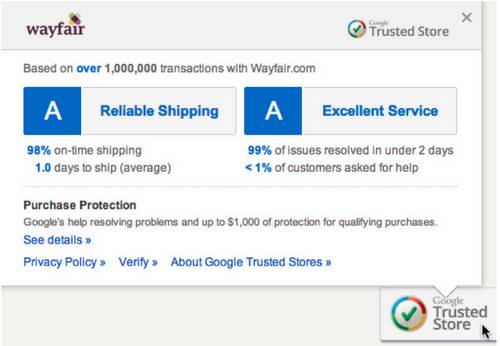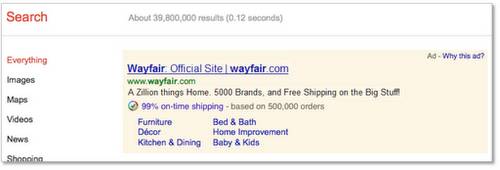Officially moved out of beta on June 7, 2012, the Google Trusted Stores program makes it easier for online shoppers to purchase from trusted e-commerce stores. Google assigns a score to participating sellers after monitoring their customer service statistics and shipping information. Merchants with a high service score can then use the Google Trusted Stores badge on their website, like Wayfair has done in this screen shot below:
A prospective customer who has never purchased from Wayfair can view their service statistics and feel confident about making a purchase from them. Customers can also opt-in to receive free purchase protection from Google. With the purchase protection, customers can contact Google’s Help Center in case of any problems and receive $1,000 in lifetime purchase protection.
As of June 2012, the Google Trusted Stores program is available only in the United States.
How It Works
The Google Trusted Stores program is designed to empower consumers and ensure that they have a positive online shopping experience. The Google Trusted Stores badge is a sign of trust from the merchant and gives shoppers the comfort of knowing that their orders will ship on time, and any order related problems will be handled swiftly.
Merchants that meet a certain threshold for the metrics Google measures can show the Google Trusted badge on their website. This badge also appears on their paid search results on Google.com and on the new Google Shopping.
This screenshot indicates how ads from Google Trusted Stores will appear on Google.com. By knowing that Wayfair has shipped 99% of 500,000 orders on time, potential customers can feel safe shopping on their website, thus increasing sales and return on investment for Wayfair.
According to the Google Trusted Stores success stories page, Wayfair managed to increase total sales by 2.2% since using the Google Trusted Stores badge, while Beau Coup, an online gift and special favors retailer, increased sales by 8.6%.
Metrics for Judging Sellers
Before allowing sellers to use a Google Trusted Stores badge on their websites, Google monitors their shipping and customer service records for a period of one month. A store with a high score can then display the badge on their website, and Google displays the store badge on Google Shopping and ad results.
Sellers are evaluated on two metrics:
Shipping –
- Maximum percentage of orders must be shipped on time, that is, within the time frame indicated at the time of purchase.
- Maximum percentage of orders must be shipped quickly.
Customer service –
- Maximum percentage of customer complaints must be resolved quickly.
- Merchants must receive low number of order related complaints.
After evaluating these statistics, Google issues a report card to participating merchants. This report card can be seen by customers by hovering over the Google Trusted Stores badge.
Consumer Protection
Customers who order from participating stores can opt-in to receive free purchase protection from Google. With purchase protection, customers can contact Google to resolve complaints and also receive $1,000 in lifetime purchase protection. Customers can report problems within 60 days of placing the order. Purchase protection covers the product cost, shipping, and any additional taxes.
Customers must first contact the merchant to solve the problem they are having with the order. If the merchant is unable to assist them, they can contact Google’s Help Center through their account.
To set up an account, customers must visit http://www.google.com/trustedstores/main and use their Google Account to sign up. In all cases, the merchant posts an issue resolution to the customer’s account. If the customer agrees with the proposed resolution, the issue is marked as closed. However, if the customer doesn’t agree with the resolution, the issue is then escalated to Google.
For example, if a customer reports that they did not receive the item they ordered, Google can ask the merchant to either ship the correct item within 14 days of your complaint or issue a complete refund.
As of June 2012, purchase protection is only available at the time of purchase.
Here is a list of issues that Google will help customers with:
- No product received.
- Incorrect product received.
- Product is broken or has been tampered with.
- Incorrect amount billed.
- Order not shipped on time.
- Return policy not honored by store.
Purchase protection also has the following limitations:
- Products cannot be returned once merchant’s return policy expires.
- Purchase protection should not be confused with product warranty.
- Lost or stolen items are not covered.
- Purchase protection is only limited to the products purchased. Google will not handle issues related to identity theft or credit card theft.
Purchase protection does not apply to some product categories, such as adult goods, counterfeit products, gambling materials, and weapons. To see a full list of products that are not covered by purchase protection click here.
Google’s Seal of Trustworthiness
Merchants that meet Google’s performance criteria can display the Google Trusted Stores badge on their website. As mentioned earlier, this badge is also displayed on Google.com ads and Google shopping results. While Google does not share the exact scores, it is suggested that merchants maintain very high scores (between 97% and 99%) to receive a badge.
Customers who see a Google Trusted Stores badge can mouse over the badge to see shipping and service statistics and also the number of transactions these statistics are based on.
In order to verify the authenticity of the badge, customers can click on the “Verify” link that appears after hovering over the badge. Clicking on the “Verify” link will take them to a badge verification page, which will be hosted on the Google.com domain.
Comparison with Amazon Prime
Way back in 2011, the Wall Street Journal mentioned that Google was planning to launch a service that could compete with Amazon Prime. While both programs have a similar premise, there are some significant differences in both services.
Amazon Prime
- $79 per year for shoppers to receive unlimited two-day shipping.
- Amazon Prime has clear data for performance metrics for sellers. Order defects must be less than 1%, and late shipments must be less than 5% for all orders.
- Amazon Prime evaluates all sellers but information is available only on a limited basis to participating consumers.
- No badge to differentiate merchant performance.
- Participating merchants highlighted on Amazon product pages.
Google Trusted Stores
- Free for merchants and consumers. Merchants must maintain quick shipping on all orders. Google may provide a one-day shipping service for a low fee sometime in the future.
- Google Trusted Stores must have on-time shipping of >90% and a cancellation rate of <2.5%. No metric for order defects specifically noted as of June 14, 2012.
- Consumers can check performance metrics for all participating merchants on their websites.
- Clearly highlighted badge on merchant website.
- Fully integrated with Google.com searches. Consumers can see Trusted Store badge on ads and in Google Shopping results.
The Google Trusted Stores program is now open to all e-tailers in the United States. To become a Google Trusted Stores partner, business owners can apply here.
Featured Image: lucidwaters via Depositphotos








